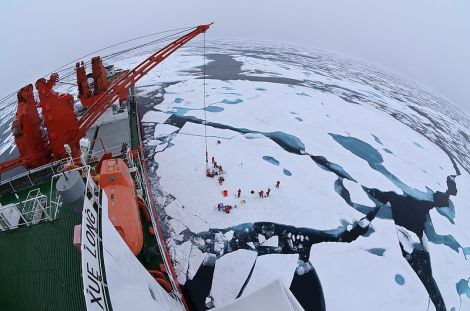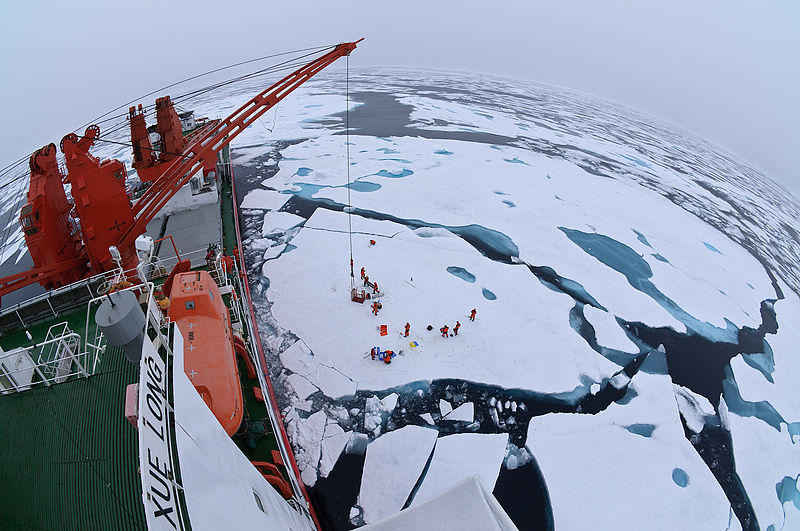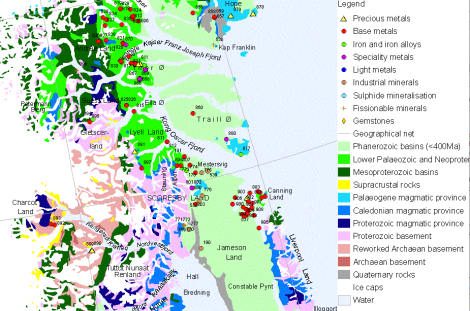
The Chinese icebreaker Xue Long. (Photo by Timo Palo.)
The New York Times has a story that’s getting a lot of traction today: The melting Arctic has set off a gold rush. Which … we knew. The Times article’s focus, though, is largely on one player: China.
While the United States, Russia and several nations of the European Union have Arctic territory, China has none, and as a result, has been deploying its wealth and diplomatic clout to secure toeholds in the region.
“The Arctic has risen rapidly on China’s foreign policy agenda in the past two years,” said Linda Jakobson, East Asia program director at the Lowy Institute for International Policy in Sydney, Australia. So, she said, the Chinese are exploring “how they could get involved.” …
To … improve relations with Arctic nations, its ministers visited Denmark, Sweden and Iceland this summer, offering lucrative trade deals. High-level diplomats have also visited Greenland, where Chinese companies are investing in a developing mining industry, with proposals to import Chinese work crews for construction.
One point the Times raises (which I hadn’t thought of) is that last month’s successful voyage through the Northwest Passage by China’s icebreaker Snow Dragon was probably as much a test run as anything.
In January, The Wall Street Journal noted China’s play in the Arctic, writing about how Denmark has made space for Chinese investment.
Denmark has made a strategic decision to prioritize its economic relationship with China and is now becoming the key gateway for Beijing’s commercial and strategic entrée into the Arctic. Denmark advocates giving China a seat at the Arctic policy table. Friis Arne Peterson, the Danish ambassador to China, stated in October that China has “natural and legitimate economic and scientific interests in the Arctic.” Copenhagen likewise supports giving China permanent membership on the Arctic Council, the eight-nation forum that includes the five Arctic Ocean coastal states (the U.S., Canada, Denmark, Norway and Russia) as well as Sweden, Iceland and Finland. …
Danish exports to China rose 17% and Chinese exports to Denmark rose 25% in 2010, according to figures provided by the Danish embassy in Beijing. Yet Danish exports to China were worth just US$2.6 billion and Chinese exports to Denmark amounted to US$6.9 billion, a small fraction of the volumes traded between China and its primary trade partners. The minerals that lie under Greenland’s snow are the real prize, worth far more in both monetary and strategic terms to China than the imported goods or export market Denmark itself can provide.
We’ve linked to this amazing map before. Prepared by the Danish government, it plots all known areas suited for mineral extraction in Greenland — an autonomous country within the Danish kingdom.
The Times article includes this dour note.
Arctic nations and NATO are building up military capabilities in the region, as a precaution. That has left China with little choice but to garner influence through a strategy that has worked well in Africa and Latin America: investing and joining with local companies and financing good works to earn good will. Its scientists have become pillars of multinational Arctic research, and their icebreaker has been used in joint expeditions.
China’s other option is to increase its own military presence in the unclaimed Arctic. The route they’re taking is probably better.
A final note: There’s a way for you, too, to make money on the catastrophic decline of ice melt in the Arctic! Over at Intrade, bettors put money on the extent of ice loss this year. You’d have done well to bet against the environment — putting you in the same league as every major nation on Earth.



